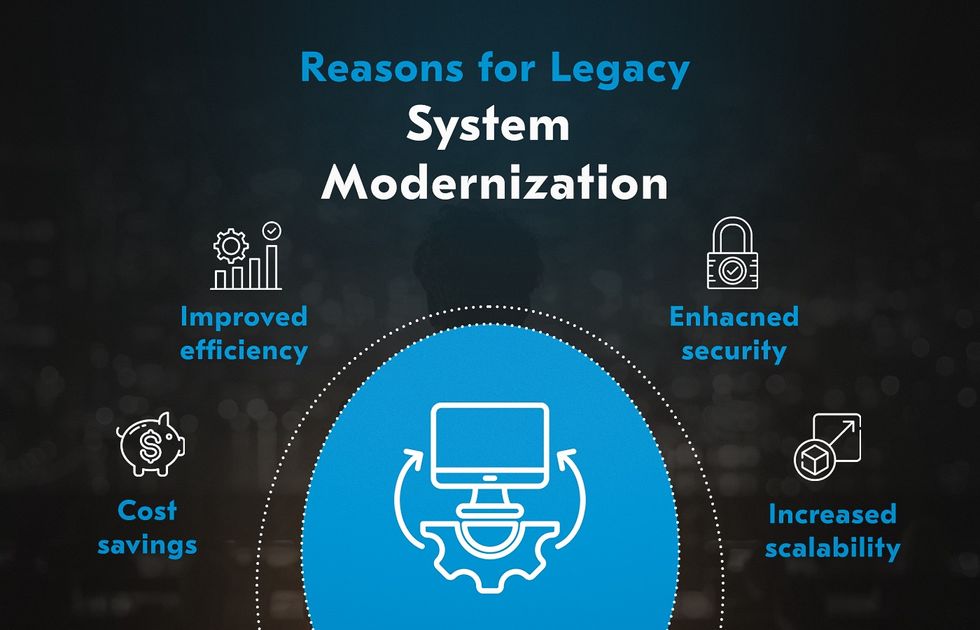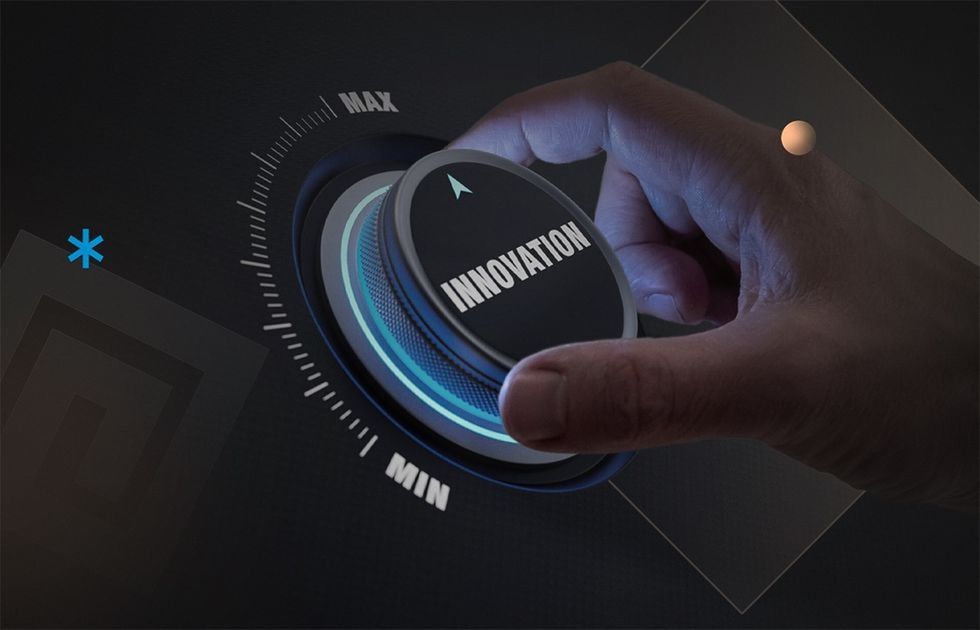
Key Takeaways
- Modernizing legacy applications enables organizations to streamline IT operations, cut infrastructure costs, and enhance resource utilization.
- Embracing legacy modernization trends leads to cost savings and improved operational efficiency, which makes businesses competitive in constantly changing tech markets.
- Legacy modernization adoption has surged. The global modernization services market was valued at $17.80B in 2023 and is projected to grow at a 16.7% CAGR.
At some point, you might find that your staff is processing payments or orders much longer than your competitors — and legacy software is the culprit. Or that users choose other companies because your app lacks a user-friendly interface and new features. In both cases, you lose customers and profit.
Another case: what is the greatest fear of healthcare app users? Data leakage. However, this is a fairly common problem for legacy apps, forcing customers to keep their health data private in more secure applications or even notepads. But you can troubleshoot this easily with modernization.
That’s exactly what Acropolium did for one of our clients. Our team standardized the documentation of several medical app vendors and optimized the infrastructure for the HIPAA-compliant medical app.
Following legacy application modernization trends, we’ll show you how to figure out that your system needs modernization and how to implement it.
Legacy Data Modernization Trends

Over the years, quite a few trends gained a foothold in legacy software modernization. In fact, the adoption of legacy modernization trends has grown significantly. The global modernization services market size was valued at $17.8B in 2023 and is projected to expand at a 16.7% CAGR.

Here is a rundown of the most relevant methods ranked by the difficulty of implementation. You can use the first couple of techniques on your own, but those down the list will need professional assistance.
Updating code
You’ve probably heard of cases when hackers took advantage of an old vulnerability just because someone was too lazy to install updates with fixes and patches.
If your code is tied to third-party libraries, make sure they’re updated to the latest versions. The same goes for frameworks. If the library’s creators stopped updating it a long time ago, it’s better to choose a more recent one and use the facade to avoid rewriting the code. The facade pattern lets you use only the elements you need, even if the library contains dozens of others.
What if your software is using outdated authentication methods? Bad news. You’re ten times more likely to be hacked. So make sure to include multi-factor and biometric authentication to your list of updates.
Using containers
Another popular trend is containerization. According to the 2024 survey, 88% of IT companies are running container technologies. Containerization is the next step in data virtualization.
It works like this: an application is broken down into small “containers” that include code, libraries, configuration files, and necessary executables — the elements it takes to run the app in most environments. However, unlike virtual machines, these containers do not have operating system images. It makes them lightweight and more portable.
This is a great benefit as developers can deploy applications easily. Engineers can create predictable environments isolated from other apps. So when it comes to building product features in a new environment, they spend less time debugging and diagnosing the differences.
Given all that, containerization is a fairly simple way to make your apps more effective and prepare the ground for future changes.
Applying the CI/CD approach and automation testing
The continuous integration/continuous deployment (CI/CD) approach isn’t new to the code philosophy. However, many companies don’t set up automated testing due to potential interoperability issues from using multiple CI/CD tools. Here, a highly specialized would do the talking.
We highly recommend adopting CI/CD to enjoy the benefits of this approach:
- CI improves code quality, and CD delivers it to the right environment as small, constant code changes are easier to track and execute.
- Modified code is tested automatically without human intervention and saves developers time and effort.
- As a result, engineers have better code to quickly introduce new features and provide users with regular, high-quality updates.
- A word of advice: you should integrate CI/CD and automation after containerizing your app. Containers offer several benefits for CI/CD, including higher levels of automation, fewer deployment errors, and lower cost and time.
Applying the DevOps philosophy

Another trend in legacy system modernization is the DevOps approach. It combines software development and operation instead of using them in isolation. The operational and development teams work closely across the entire product lifecycle, which benefits product quality and user experience.
By 2024, banking will lead the top industries investing in solutions for automated loan processing, with 80% of finance leaders focusing on robotic process automation.
DevOps is all about automation, including CI/CD processes, microservices, and information exchange. However, a DevOps engineer remains a key team player. They monitor how effective continuous communication and changes are, identify shortcomings, and ensure that the whole process runs smoothly.
By switching to the DevOps approach as one of the legacy modernization trends, you’ll get faster deployment and better product quality. The catch is that you’ll need an experienced professional on your team to implement it.
Improving the mobile experience and using the mobile-first approach
The mobile-first approach is one of the most common trends in legacy system modernization. But first, you have to think of the best way to implement it in your system: should you create a web version to access it from any device or a separate mobile application?
In any case, such an upgrade will give you an edge. For example, the Lumia Coffee store increased its revenue by 70% in just nine months by creating mobile apps to sell its products in addition to its Shopify web store.
Using A/B testing and feedback analysis
This trend is driven by the need to know exactly what to change before modernizing your legacy software and migrating essential data. The best way to find it out is A/B testing: you give two groups of people different types of features and compare their reactions. The one with a better response will be integrated into the software.
You can also analyze product reviews posted in public. However, this data might not be enough because many people are too lazy to post feedback — especially the positive one. It’s smarter to mix the review analysis with A/B testing.
Building AI сhatbots
Artificial intelligence (AI) сhatbots have become a top legacy modernization trend in recent years. Even though they are complicated to develop, the benefits they bring are huge. According to Outgrow statistics, chatbot technology has been shown to boost sales by 67%.
Unlike rule-based bots, AI bots do not require an extensive database, so most companies can easily adopt them. The difference is that rule-based bots cannot find the answer if it is not in their database. The AI bot, however, is self-learning, so you only need to provide clear initial data, even if it is limited.
It’s a go-to choice for businesses offering customer support since a well-designed bot can eventually replace dozens or even hundreds of customer care agents.
Migrating to the cloud

One of the most complex but crucial methods of legacy app modernization is cloud migration. Standing among the top legacy modernization trends, cloud storage offers multiple goodies:
- Speeds up information exchange
- Prevents security breaches
- Facilitates data transfer and processing
- Improves third-party software integration
- Cloud-based software, whether SaaS or BaaS, simplifies the implementation of DevOps, making data accessible to AI, and developing SaaS-based mobile apps or MVPs.
However, migration can be a major challenge if your software has outdated databases and libraries or is overcomplicated. In this case, it’s best to turn to a professional software outsourcing team for help. They will determine the most appropriate methods and steps of migration to save all your data and effectively organize it on a new platform.
Acropolium has over a decade of experience in custom SaaS development and more than 93 successful cloud migrations of various complexity. We overcame quite a few roadblocks migrating data for small companies and international enterprises, and our team is fully equipped to handle this mission for you. All you need to do is get in touch with our managers.
Legacy System Modernization Benefits

Most legacy modernization trends will soon turn into classic approaches to software maintenance due to the tangible benefits the upgrade can bring to businesses.
Cost Savings
Upgrading outdated systems can substantially lower infrastructure and operational costs. Modern technologies often require less hardware and energy, leading to reduced expenses.
Improved Efficiency
Modernizing legacy software streamlines IT operations, reducing the resources required for maintenance and updates. This contributes to faster processing times and more efficient workflows.
Enhanced Security
Modern software incorporates the latest security protocols, protecting against vulnerabilities and cyber threats that older systems may be susceptible to. This ensures better data protection and compliance with current regulations. However, if you plan to modernize software with an outsourcing vendor, make sure they follow the latest cybersecurity practices to avoid risks.
Increased Scalability
Modernized systems are designed to handle growth and can easily scale to address increasing workloads and user demands. By adopting legacy system modernization trends, businesses obtain the flexibility to expand without being constrained by outdated technology.
Why Legacy Modernization Will Always Stay Relevant

If you look closely at the legacy modernization trends, you’ll see why software upgrades will always be relevant.
Tech competitiveness
With containerization, DevOps, and automation, new apps and features will reach the market faster, and the software will quickly grow outdated.
Multi-platform accessibility
There has been a significant boost in multi-cloud systems and cross-platform development. In 2023, the cross-platform software market was valued at $74.42B. Now, it is expected to reach $174.78 billion by 2030, growing at a 15.67% CAGR from 2024 to 2030.
You’ll either spend a fortune building apps for multiple platforms or lose customers sticking to only one.
Advanced cybersecurity opportunities
Similar trends can be observed in cybersecurity. According to Entrepreneur, emerging security threats force IT specialists to deviate from traditional cyber protection methods. Instead, they implement a cybersecurity mesh during software development.
By failing to update your software, you leave security gaps and increase the risk of data breaches. The chances of facing lawsuits, suffering reputational damage, and losing your customer loyalty grow, too.
AI adoption
While 2023 marked the discovery of generative AI, 2024 is when organizations started leveraging it for business value. According to a recent McKinsey survey, 65% of respondents report their organizations are regularly using generative AI. Without AI-empowered software, you will be lagging behind your competitors and driving clients away.
Developing new software from scratch over and over is too expensive, time-consuming, and, sometimes, hardly possible. That’s why companies modernize their legacy software to integrate new features so as not to lose efficiency, customer loyalty, and profit.
How to Understand That Your Legacy System Needs Modernization

Before jumping headfirst into modernization techniques, double-check that your software is truly outdated. Most of the time, it’s enough to ask yourself if you are happy with your application.
Poor performance
If you, your employees, and your customers struggle to use your app and request considerable changes, you need to modernize it.
In 2017, Equifax had to deal with a huge data breach due to vulnerabilities in outdated software, exposing the sensitive personal information of millions of consumers. The breach resulted in legal consequences, fines, and a loss of customer trust.
Incorrect functionality
If your system shows software failures, doesn’t fulfill its original goal, and fails to satisfy its users, there’s a need for a major overhaul. Should you feel unhappy with particular services, upgrade them or create new ones. Usually, this is the case if your software:
- Doesn’t integrate with other services
- Is no longer supported by its vendors
- Cannot be updated by developers as they moved to other technologies or quit
- Has severe security issues that cannot be fully addressed
- Is based on an operating system no longer in use
- Cannot be scaled
The Commonwealth Bank of Australia faced a significant outage in 2018 due to outdated software, impacting online banking services, ATMs, and electronic payments. The outage affected millions of customers and raised questions about the bank’s IT resilience and readiness for digital banking demands.
Need for replacement
Sometimes, there is no other option but to replace the software. This is the case if:
- Customers refuse to use the application, finding it user-unfriendly and slow
- Employees keep complaining about errors or do not understand its purpose
- Writing things down in a notepad is easier than using the app
- The cost of the application overrides its benefits
- The software does not meet the company’s goals
If you can relate to one or several of these points, you might well be losing your profit by missing the benefits of modern technologies. Follow legacy modernization trends and strategies to get your business back on track.
Acropolium’s experience
A company facing legacy modernization trends for the first time can find it challenging to deal with them. However, we have more than ten years of experience in legacy software modernization, helping our clients improve their businesses.
Over the past decade, Acropolium has successfully modernized 58 software solutions for companies across industries.
We assisted a healthcare company in increasing customer loyalty by modernizing its app’s architecture and security. We boosted the tech knowledge of an automotive company’s in-house team by choosing the right tech stack and creating a data-driven SaaS platform for scalable applications.
Our development team also helped a fintech company modernize AI contracting software. After implementing advanced algorithms and setting up integration features, the client reduced contract review times by 75%.
Finally, we helped a leading Ukrainian hotel chain to optimize a single server-based application into a scalable cloud-based hotel chain management system. As a result, the client reduced the costs by 40% and increased the annual profit by 30%.
Conclusion
Legacy modernization trends are diverse and market-driven. Some of them can be implemented in several clicks; others need professional help. But they all have a common goal — to make business more efficient.
On top of that, most trends are interconnected and work better as a whole. Still, you can implement each of them separately: the main thing is to identify weaknesses to be modernized.
Acropolium’s portfolio shows that we’re fully equipped to meet all kinds of requests related to legacy software, from auditing and consulting to complete system modernization. Get in touch with us and let your upgraded software benefit your business.














